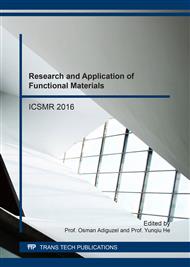[1]
K. Kinoshita and P. Stonehart, in: Preparation and characterization of highly dispersed electrocatalytic materials, in Modern aspects of electrochemistry, Springer, (1977), p.183–266.
DOI: 10.1007/978-1-4615-7452-1_4
Google Scholar
[2]
J. H. Sinfelt, in: Bimetallic catalysts: discoveries, concepts, and applications, vol. 7. Wiley-Interscience, (1983).
Google Scholar
[3]
J. H. Sinfelt, in: Ruthenium-copper: a model bimetallic system for studies of surface chemistry and catalysis, Int. Rev. Phys. Chem., vol. 7, no. 4, p.281–315, (1988).
DOI: 10.1080/01442358809353215
Google Scholar
[4]
A. F. Lee, J. A. Bennett, J. C. Manayil, and K. Wilson, in: Heterogeneous catalysis for sustainable biodiesel production via esterification and transesterification, Chem. Soc. Rev., vol. 43, no. 22, p.7887–7916, (2014).
DOI: 10.1039/c4cs00189c
Google Scholar
[5]
C. Walkey, S. Das, S. Seal, J. Erlichman, K. Heckman, L. Ghibelli, E. Traversa, J. F. McGinnis, and W. T. Self, in: Catalytic properties and biomedical applications of cerium oxide nanoparticles, Environ. Sci. Nano, vol. 2, no. 1, p.33–53, (2015).
DOI: 10.1039/c4en00138a
Google Scholar
[6]
C. Xu and X. Qu, in: Cerium oxide nanoparticle: a remarkably versatile rare earth nanomaterial for biological applications, NPG Asia Mater., vol. 6, no. 3, p. e90, (2014).
DOI: 10.1038/am.2013.88
Google Scholar
[7]
S. Patil, S. C. Kuiry, S. Seal, and R. Vanfleet, in: Synthesis of nanocrystalline ceria particles for high temperature oxidation resistant coating, J. Nanoparticle Res., vol. 4, no. 5, p.433–438, (2002).
DOI: 10.1023/a:1021696107498
Google Scholar
[8]
A. Trovarelli, in: Catalytic properties of ceria and CeO2-containing materials, Catal. Rev., vol. 38, no. 4, p.439–520, (1996).
Google Scholar
[9]
J. Kašpar, P. Fornasiero, and M. Graziani, in: Use of CeO 2-based oxides in the three-way catalysis, Catal. Today, vol. 50, no. 2, p.285–298, (1999).
DOI: 10.1016/s0920-5861(98)00510-0
Google Scholar
[10]
A. Corma, in: From microporous to mesoporous molecular sieve materials and their use in catalysis, Chem. Rev., vol. 97, no. 6, p.2373–2420, (1997).
DOI: 10.1021/cr960406n
Google Scholar
[11]
C. T. Kresge, M. E. Leonowicz, W. J. Roth, J. C. Vartuli, and J. S. Beck, in: Ordered mesoporous molecular sieves synthesized by a liquid-crystal template mechanism, Nature, vol. 359, no. 6397, p.710–712, (1992).
DOI: 10.1038/359710a0
Google Scholar
[12]
F. Schüth, in: Non-siliceous mesostructured and mesoporous materials, Chem. Mater., vol. 13, no. 10, p.3184–3195, (2001).
DOI: 10.1021/cm011030j
Google Scholar
[13]
Y. Wan and D. Zhao, in: On the controllable soft-templating approach to mesoporous silicates, Chem. Rev., vol. 107, no. 7, p.2821–2860, (2007).
DOI: 10.1021/cr068020s
Google Scholar
[14]
Y. Deng, T. Yu, Y. Wan, Y. Shi, Y. Meng, D. Gu, L. Zhang, Y. Huang, C. Liu, and X. Wu, in: Ordered mesoporous silicas and carbons with large accessible pores templated from amphiphilic diblock copolymer poly (ethylene oxide)-b-polystyrene, J. Am. Chem. Soc., vol. 129, no. 6, p.1690–1697, (2007).
DOI: 10.1021/ja067379v
Google Scholar
[15]
D. Zhao, Q. Huo, J. Feng, B. F. Chmelka, and G. D. Stucky, in: Nonionic triblock and star diblock copolymer and oligomeric surfactant syntheses of highly ordered, hydrothermally stable, mesoporous silica structures, J. Am. Chem. Soc., vol. 120, no. 24, p.6024–6036, (1998).
DOI: 10.1021/ja974025i
Google Scholar
[16]
S. J. Gregg and K. S. W. Sing, in: KSW Adsorption, surface area and porosity., London: Academic, (1982).
Google Scholar
[17]
J. van der Meer, I. Bardez, F. Bart, P. -A. Albouy, G. Wallez, and A. Davidson, in: Dispersion of Co 3 O 4 nanoparticles within SBA-15 using alkane solvents, Microporous Mesoporous Mater., vol. 118, no. 1, p.183–188, (2009).
DOI: 10.1016/j.micromeso.2008.08.053
Google Scholar
[18]
E. V Todorova, G. E. Chernev, and S. P. Djambazov, in: Structure and properties of functionalized porous silica hybrid materials, Open J. Inorg. Non-Metallic Mater., vol. 2014, (2014).
DOI: 10.4236/ojinm.2014.43006
Google Scholar
[19]
O. Oprea, D. Ficai, A. Ficai, and C. Guran, in: Synthesis Of Ceo 2 Nanoparticles On The Mesoporous Silica Support Via Nanocasting, vol. 9, no. 1, p.187–195, (2014).
Google Scholar
[20]
J. J. Ketzial and A. S. Nesaraj, in: Synthesis of CeO2 nanoparticles by chemical precipitation and the effect of a sur-factant on the distribution of particle sizes, J. Ceram. Process. Res., vol. 12, no. 1, p.74–79, (2011).
Google Scholar


